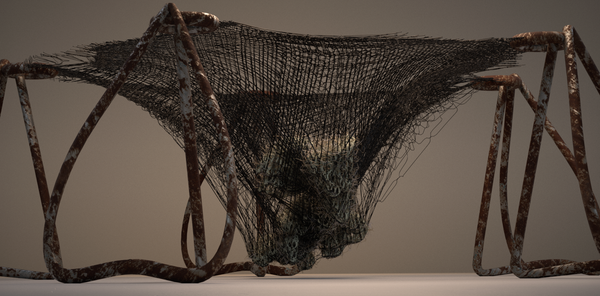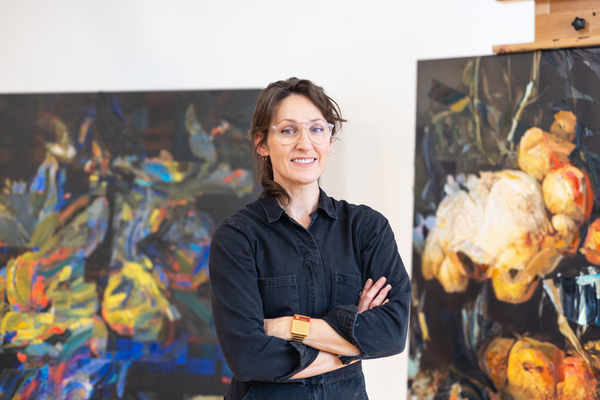In Search of Bas Jan Ader, the Artist Who Disappeared at Sea
In 1975, artist Bas Jan Ader attempted to sail across the Atlantic. The discovery of his boat 10 months later sparked a fetishistic fascination with his disappearance.

On April 18, 1976, approximately 150 nautical miles from the southwest coast of Ireland, the crew of a Spanish fishing trawler, the Eduardo Pondal, spotted an object floating in the water. As the crew approached, they saw that it was a small sailing boat. The vessel was floating vertically, its bow completely submerged. After hoisting the boat onto the trawler’s deck, the Pondal’s crew conducted a search of its cabin. Amongst spoiled cans of food and nautical equipment, they found four forms of identification: a passport, driver’s license, health insurance card, and a University of California, Irvine ID. The boat was named Ocean Wave, and it belonged to the conceptual artist Bas Jan Ader. Based on the barnacles attached to the boat’s hull, the captain of the Pondal, Don Manual Castineira Alfeirán, concluded that the Ocean Wave was adrift for around six months. Ader’s body was never recovered.
Ader had set sail from Chatham, Massachusetts, 10 months earlier on July 9, 1975. His departure was documented by his wife, Mary Sue Ader Andersen, who photographed Ader on board the Ocean Wave as it was towed out from the harbor. Ader’s destination was Falmouth, England. From there, he was to travel to the Groninger Museum in the Netherlands for an exhibition of his work. The artist conceived of his journey, which was estimated to take anywhere between two to three months, as part of an artwork titled “In Search of the Miraculous.” Had he succeeded, the Ocean Wave would have been the smallest boat to cross the Atlantic. Ader took a camera and several notebooks with him — none of which were recovered. A number of questions arose in the wake of the artist’s disappearance. What happened to him? Was he really dead or had he staged his disappearance? Did he commit suicide, and if so, had that been his intention the entire time? These questions became more pointed due to the artistic nature of Ader’s journey. The resulting narrative was impossible to resist. He was the artist who had died for his art.
In May 1976, a little over a month after the discovery of the Ocean Wave, the editors of Avalanche art magazine, Liza Béar and Willoughby Sharp, published a transcript of a phone interview with Andersen in the summer issue of 1976, in which they repeatedly probed the nature of Ader’s intentions. The final exchange, which is also the most quoted part of the interview, encapsulates the reactions to his disappearance:
Mary Sue Ader [Andersen]: I heard a lot of his students were so incapable of living with the reality of it that they were fantasizing all kinds of situations …
Willoughby Sharp: Escapes?
Liza Béar: Starting another life somewhere else?
Mary Sue Ader [Andersen]: Uhhuh. They had rumors going for months that he was alive and well.
Willoughby Sharp: There was no sense of him wanting that kind of thing or thinking ……
Mary Sue Ader [Andersen]: Oh no.
Willoughby Sharp: ….. this was the ultimate piece and er …. committing suicide.
Mary Sue Ader [Andersen]: No. I’m absolutely convinced that was nowhere in his consciousness. We talked about it, and he assured me repeatedly these were not his intentions.
Aside from the Avalanche interview, Ader’s death received little attention at the time. It wasn’t until 1985 that the first posthumous solo exhibition of his work was held. The artist’s reputation later spiked during the 1990s, largely due to the art world’s renewed preoccupation with conceptualism. The interest in his disappearance inevitably resurfaces whenever his work is exhibited or discussed, a painful reality that Ader’s widow has had to embrace. “I know what’s the truth and so it doesn’t matter what they think,” Andersen stated in a 2009 interview for the Claremont Museum of Art. “I’ve gotten totally used to the idea that people are gonna talk about it and write about it.” The rumors that followed in the wake of Ader’s disappearance were largely borne of the themes that he explored in his work. Ader’s interest in fate, failure, adventure, and absence lent a certain psychological credence to the absurd notion that he had merely hidden himself.
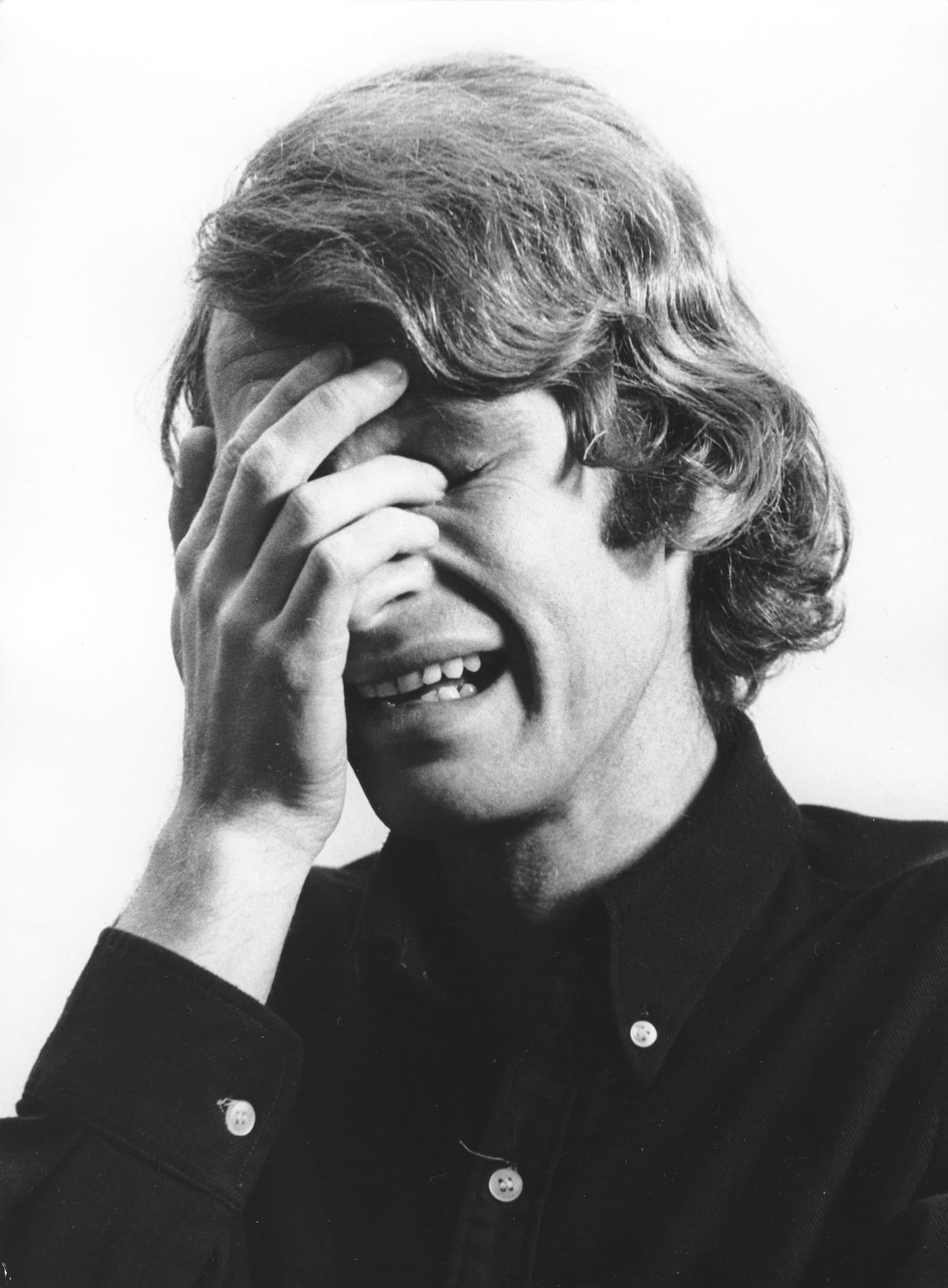
Over the course of the last decade, the interest in Ader’s work has largely stepped away from a cultish fixation on his death towards a greater appreciation of his entire oeuvre. This summer saw two solo exhibitions of the artist’s work, one at Metro Pictures in New York, the other at Simon Lee Gallery in London. The press release for the latter makes only a passing reference to the artist’s disappearance.
Ader’s mythic status is the subject of a 1996 episode of NPR’s This American Life. Titled “From a Distance,” the episode explores the theme of hero worship. The opening segment follows Erika Yeomans, an artist infatuated with the work of “a virtually unknown Dutch artist.” Yeomans recalls coming across a photograph of Ader’s, “I’m Too Sad to Tell you” (1971), a work he later made into a short film. In each piece the camera focuses tightly on Ader’s face as tears stream down his cheeks (emphasis mine):
I just think I’m intrigued because [the photo] shows a man crying. And you don’t see that image very often. And you don’t see a man letting himself have these true emotions. And yet he kind of pushes it away a little bit by sort of writing on there “I’m too sad to tell you.”
There was just something very appealing about it and sad. And I felt like I identified with that longing. And longing for what? I don’t know. A searching for something? What is it? I didn’t know. And I wanted to know what he was thinking.
Yeomans later describes how she imagined Ader’s final journey:
I envisioned him catching his fish off the side of the boat and having a little mock-up barbecue pit and grilling his fish and having his fresh water supply, eating very little, fasting for a lot of it, and writing a lot in his journals.
Yeomans’ transition from discussing one work to the other is revealing. Both pieces actively restrict the viewer’s access, requiring us to imagine the circumstances in which they were produced. We don’t know the cause of Ader’s upset in “I’m too Sad to Tell you.” The title is designed to activate a mystery while perpetuating the viewer’s pity and concern. Likewise, the experience of “In Search of the Miraculous” was known only to Ader. The latter work primarily exists as a single black-and-white photograph, reproduced for one of Art & Project gallery’s renowned (and now highly coveted) bulletins. The image shows Ader on board the Ocean Wave with his back turned to the camera — his thin frame contrasted against the vastness of the ocean. The image itself is fairly generic. It tells us nothing of the hardships that Ader surely faced — the need to stay awake for long hours, rationing supplies, and dealing with inclement weather. The photograph intentionally emphasizes the limits of representation. Like a postcard sent without a message, the photograph can only provide a highly abstracted and idealized sense of a traveler’s journey.
Ader’s art grappled with the notion that our individual experiences cannot always be adequately captured or conveyed. The artist was searching for something “miraculous,” but even if he were to have found it, who’s to say whether he could adequately convey it? It’s a theme that recurs throughout Ader’s small, but remarkably consistent body of work. His oeuvre presents an affecting blend of Sisyphean struggle, absurdist humor, and humanist concern.
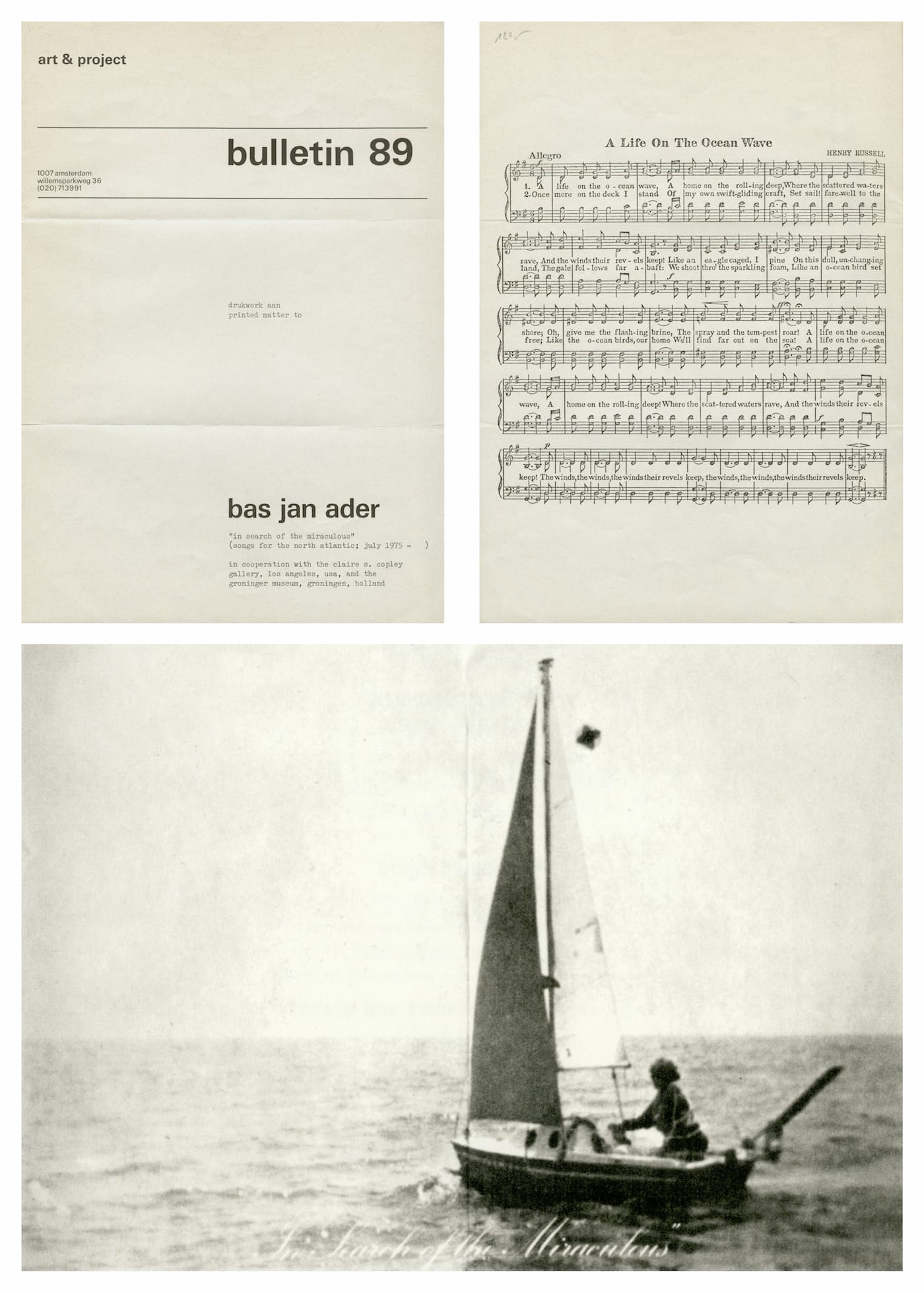
Aside from his final piece, Ader’s best known body of work is a set of 16mm films known as the Fall series. Each film was recorded in a single static take. “Fall 1, Los Angeles” (1970) opens with Ader sitting on a chair on the roof of his home. The camera is set at a distance, with only the house and Ader occupying the frame. The artist suddenly leans to his right, loses control, and begins to roll off the roof and into the bushes below. The work’s levity is bolstered by the artist’s use of slow motion. In an extra-comic twist, one of Ader’s shoes flies off before he hits the ground. Another film from the same year, “Fall 2, Amsterdam” (1970), is presented at normal speed. The camera overlooks a road beside a canal. Ader enters the frame on a bicycle, cycling steadily. He abruptly swerves into the water a few seconds later. Crucially, both sequences are cut before we see Ader remerge. He essentially vanishes.
Heralded for its Keatonesque humor, the Fall series oscillates between farce and tragedy. The films embrace the themes of failure, determinism, and fate. In a 1971 interview with Avalanche magazine (issue 2, winter 1971) Ader stated:
I do not make body sculptures, body art, or body works. When I fell off the roof of my house, or into a canal, it was because gravity made itself master over me.

Ader’s remark explains his decision to commence each film shortly before the falls occur. The emphasis is on the act of falling itself, as opposed to the situation depicted. It is meaningful that we do not see Ader climb onto the roof of his house (footage which was excised from the final version of “Fall 1”) or mount his bicycle, as this would undermine the apparent spontaneity of each action. If the films could be said to have a flaw, it is that Ader is required to activate the falls himself — a fact that threatens to undermine the work’s determinist themes. Ader resolved this problem with “Broken Fall (Organic)” (1971). The film opens with the artist dangling from a tree branch above a creek. In this instance, Ader has placed himself into a scenario where a fall is inevitable. The artist is no longer in control. The viewer knows that Ader’s strength will eventually give way. Here, the Sisyphean quality of the work is both fully articulated and exercised.
The sense of failure and tragic inevitability that Ader conveyed so effectively in his Fall series would later be conflated with the mystery of “In Search of the Miraculous.” The thematic continuums are almost impossible to ignore, and numerous viewers and critics have fetishized it, perhaps without even realizing it. Consider this passage by Cathleen Chaffee in the catalogue for the Museum of Modern Art’s 2009 exhibition In & Out of Amsterdam: Travels in Conceptual Art, 1960–1976:
[Ader’s] early, dramatic death shaped [his] posthumous reputation as a tragic daredevil and an anachronistic, poetic wanderer. The artist himself also encouraged this kind of response to his work by employing in this final project old fashioned themes such as death defying risk, the lust for adventure, and the pathos of homesickness.
The very themes that Chaffee describes are, for the most part, already present in Ader’s earlier work. The artist’s falls, though not exactly “death defying,” presumably involved a certain degree of personal risk. Likewise, Ader’s off-screen disappearances in “Fall 1” and “Fall 2” preempted his later interest in presence and absence, themes that Ader would later explore with “In Search of the Miraculous.” These thematic continuums readily lend themselves to retroactive readings of the artist’s work. It explains why Yeomans jumps from discussing “I’m Too Sad to Tell You” to “In Search of the Miraculous.” When Yeomans analyzes the former, she identifies a sense of longing in Ader’s expression — “A searching for something.” Her language demonstrates that she has conflated the two works. You get the sense that Yeomans is looking for answers in Ader’s earlier work; that “I’m Too Sad to Tell You” might somehow account for Ader’s state of mind or purpose prior to his disappearance.
These connections, more psychological than art historical, explain the intensity of Ader’s mythic status. It’s all too easy to read Ader’s absence at the end of “Fall 1” and “Fall 2” as some sort of grim foreshadowing of his death. It’s therefore unsurprising that so many of Ader’s students devised alternative theories, chief among them that Ader had staged his disappearance. One imagines that Ader’s students preferred to treat “In Search of the Miraculous” as one of his Fall films — as if Ader was merely off-camera, quietly devising his next scenario.
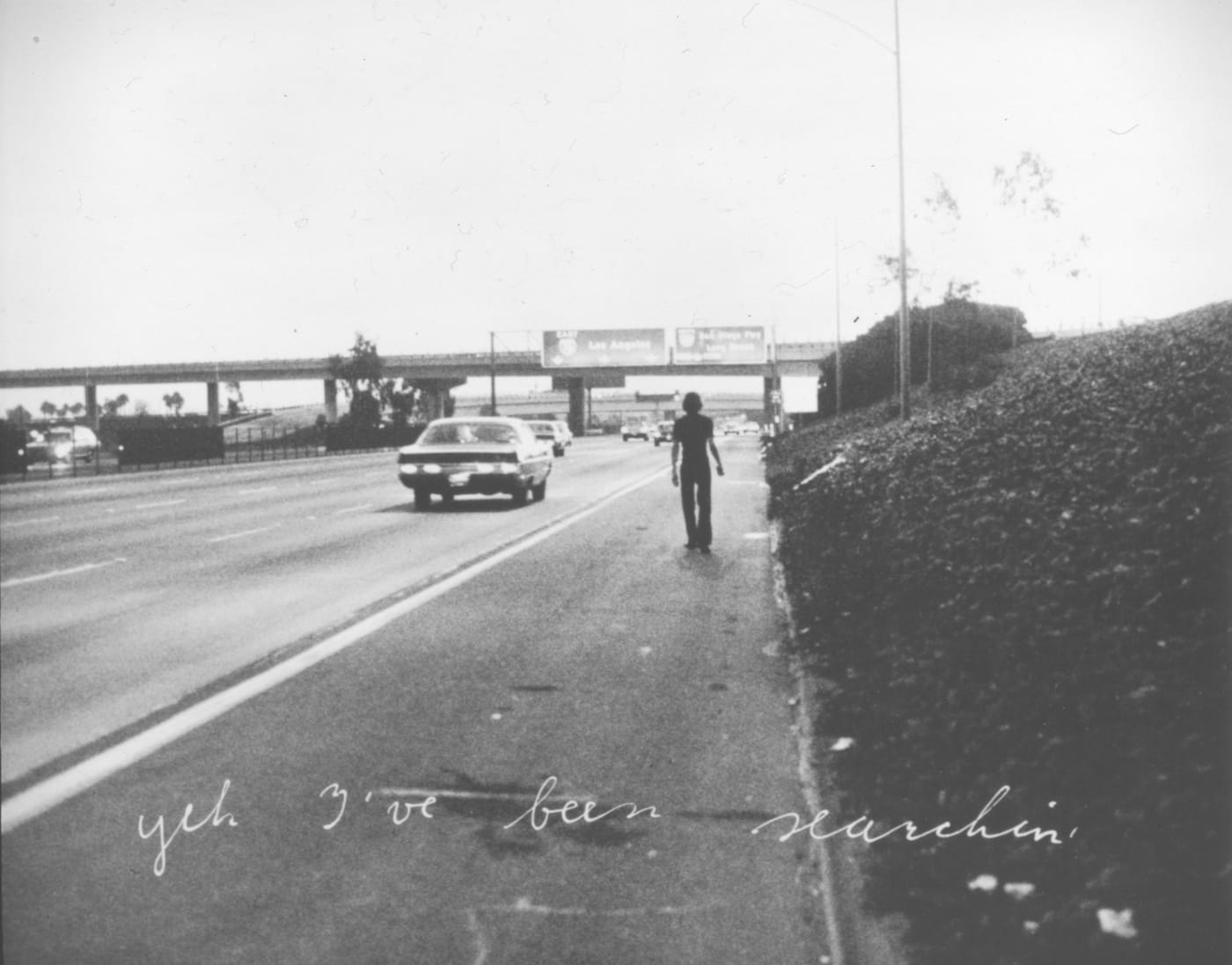
As with the first two Fall films, the structure for “In Search of the Miraculous” was geographic. The work began as a series of black-and-white photographs entitled “In Search of the Miraculous (One Night in Los Angeles)” (1973). Two versions of the work exist, one comprised of 14 prints, the other 18. The photographs document Ader as he wanders around the city, presumably searching for a miracle. Each image is accompanied by handwritten lyrics from the 1957 song “Searchin’” by the Coasters:
Well, now, if I have to swim a river
You know I will
And-a if I have to climb a mountain
You know I will
And-a if she’s a-hiding up on a-blueberry hill
Am I gonna find her, child, you know I will
‘Cause I’ve been searchin’ (gonna find her)
Oh, yeah, searchin’ (gonna find her)
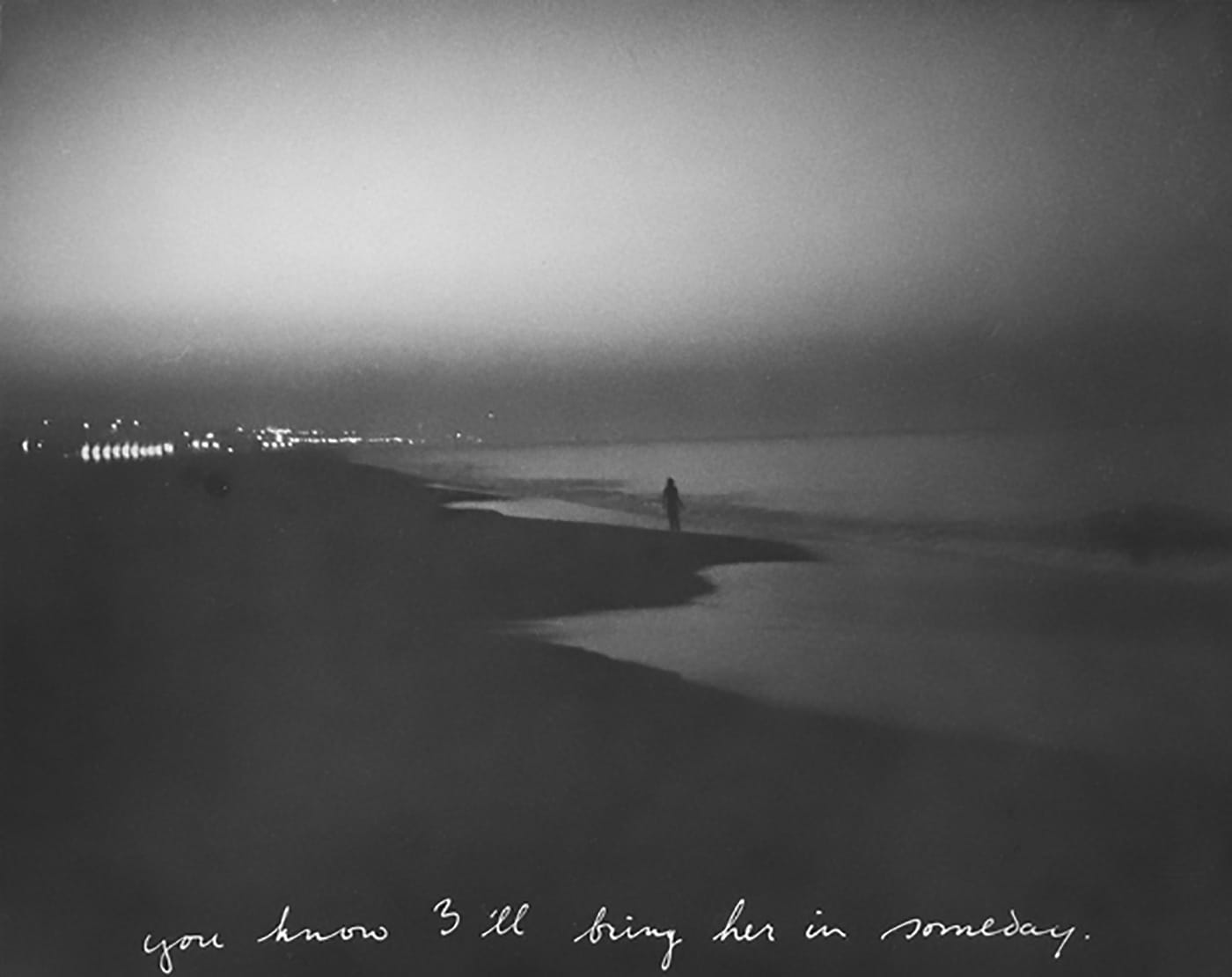
The series ends with a photograph of Ader standing on a beach before the ocean. In each image, the artist is either captured from behind, or obscured by shadow. Ader remains both physically, and emotionally, a spectral presence. We’re forced to imagine what he is searching for. It’s tempting to read the work, to use Chaffee’s phrase, as an embodiment of the “pathos of homesickness.” Might Ader be searching for home? The first two Fall films, split as they are between Los Angeles and Amsterdam, purposely spotlight Ader’s identity as a Dutch-born US national. “In Search of the Miraculous” also bridged the distance between the US and the Netherlands. The work is typically described as a triptych. The first part was an exhibition of Ader’s work at the Claire Copley gallery in LA, held between April 22–May 17, 1975. The second part was Ader’s journey across the Atlantic, and the third would have been a restaging (and possibly an expansion) of the Copley exhibition at the Groninger Museum.
Ader had sailed across the Atlantic before. While traveling in Morocco in 1962, the artist befriended Neil Tucker Birkhead, an American in need of a crewmate for his sailing vessel, the Felicidad. Their journey to Los Angeles, where Ader then settled, was fairly disastrous. The yacht was damaged by storms several times, and had to be towed on two occasions. Knowing this, it’s easy to read “In Search of the Miraculous” as a return journey of sorts. If Ader was searching for home, he most likely knew that such a place no longer existed, hence his search for “the miraculous.” “You can’t go home again,” remarks Rene Daalder, in his 2007 documentary on Bas Jan Ader, Here is Always Somewhere Else, “there is no such a place after you’ve emigrated.”
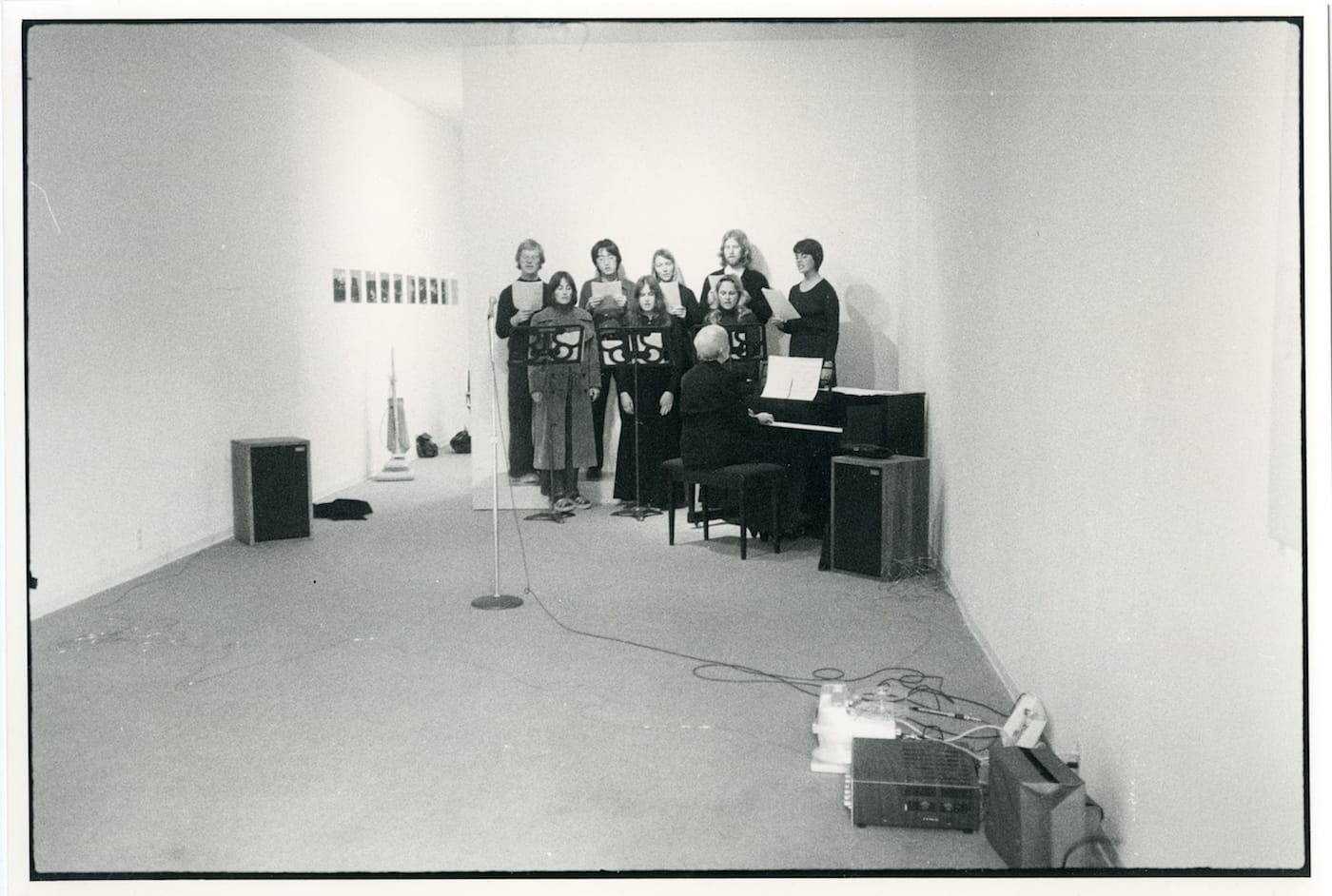
Ader’s exhibition at the Claire Copley gallery provides the clearest indication of his thematic ambitions for “In Search of the Miraculous.” The exhibition included “In Search of the Miraculous (One Night in Los Angeles)” and a display of lyrics to 19th-century sea shanties. One of the songs included Epes Sargent and Henry Russell’s “A Life on the Ocean Wave” (1838), which was later reproduced alongside the black-and-white sailing photo in Ader’s Art & Project bulletin. Ader recruited a small group of his students from UC Irvine (all of whom were dressed in black) to sing the shanties with a pianist. He then projected photographs of their performance onto the walls of the gallery. These images, which were shown with the use of a carousel projector, were accompanied by an audio recording of the performance. It’s important to note that the choir sang live during the show’s opening. Ader had thus replaced live, unmediated experience with mediated reproductions, returning once again to the dilemma of representation. Lyrics such as “Oh Give me the flashing brine! The spray and the Tempest Roar/ A life on the ocean wave!,” much like Ader’s sailing photograph, can never fully articulate the experience of being alone at sea. The dated vernacular of the sea shanties emphasized the gulf between the sea farer (Ader) and those to whom he would later recount his experiences. Ader would be the only one present for his journey. For everyone else, including his wife, “In Search of the Miraculous” would be experienced as an absence.

Ader had made preparations for a Dutch choir to sing the shanties at the Groninger Museum and had also planned to exhibit photographs of a night walk through Amsterdam, thereby implying that “the miraculous” had yet to be found. It’s not known whether Ader intended to display documentation related to his journey. Months after he had set sail, Mary Sue Ader Andersen, and Erik Ader — Bas Jan’s brother — alerted numerous embassies of the artist’s failure to make landfall. “In the back of my mind, I always held out that hope, that he just disappeared and was gonna come back,” Andersen states in her Claremont Museum interview. “So I kept him alive that long, until January first of ’78. When that didn’t happen, then I started to have him declared dead. I got a lawyer and went to court and they said he was presumed dead, lost at sea.” Erik Ader, an experienced sailor, concluded that his brother had been knocked overboard. Spanish authorities had observed that The Ocean Wave’s washboards had been ripped from their casing, possibly caused by tension from Ader’s lifeline. The fact that Ader’s lifejacket wasn’t found suggests that the artist had been wearing it when he was separated from his boat. In a bizarre twist, the Ocean Wave was stolen (most likely for salvage) before either Andersen or Erik Ader were able to inspect it.
Recent projects have tended to mitigate the mythic construction of Ader’s identity. Of these projects, two have stood out in their effort to separate the man from the mystery: Rene Daalder’s 2007 documentary, Here is Always Somewhere Else, and Alexander Dumbadze’s monograph, Bas Jan Ader: Death is Elsewhere (University of Chicago Press, 2013). Although both projects are occupied with Ader’s disappearance (Daalder’s especially so), both contextualize the artist’s work within broader frameworks. Dumbadze contrasts Ader’s work with other artists from LA’s conceptual art scene, most notably Chris Burden, whilst Daalder relates the artist’s work to his Dutch peers, particularly Ader’s close friend Ger van Elk, and the Fluxus artist Wim T. Schippers.
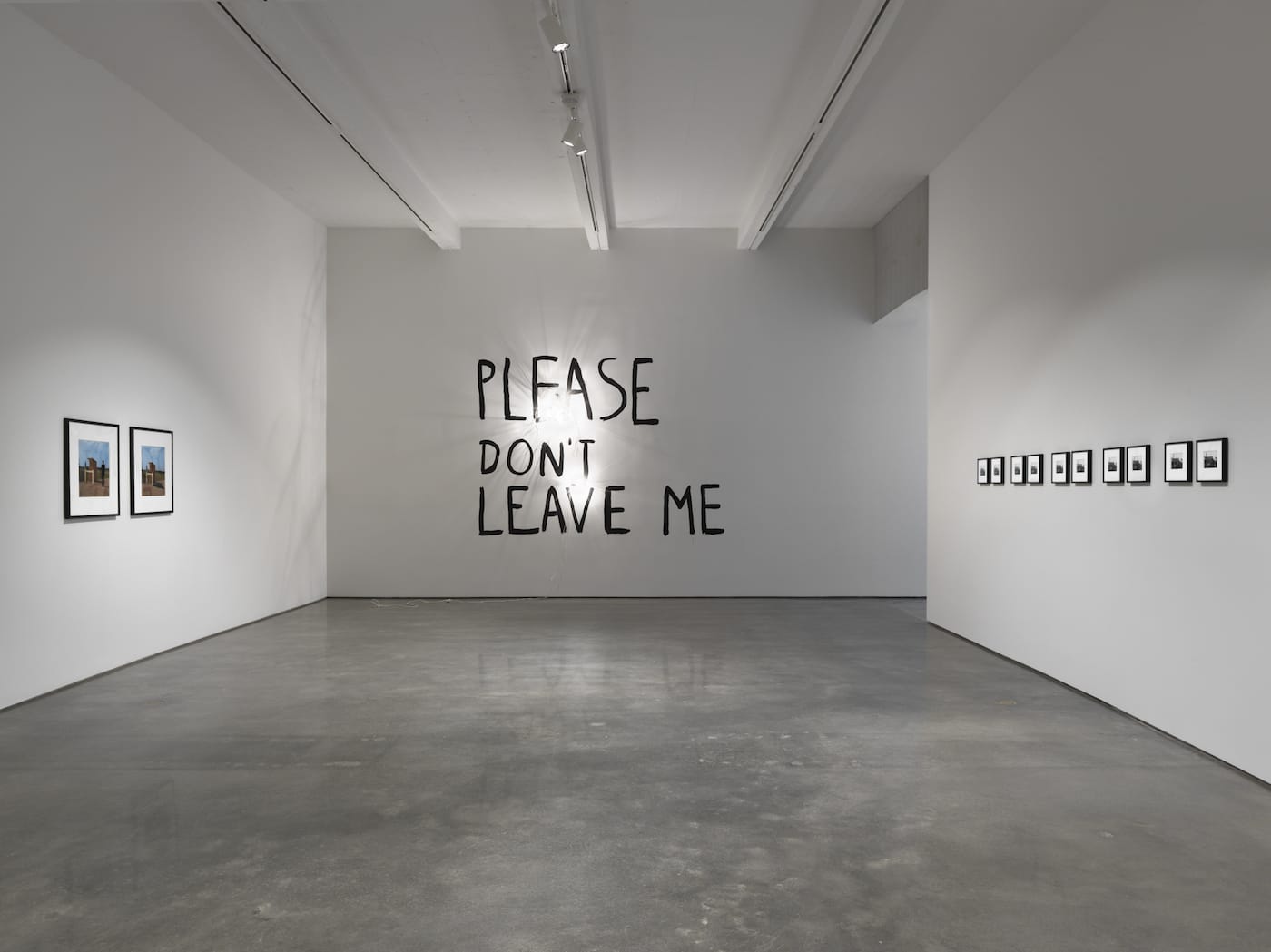
In a Q&A included in the documentary’s DVD, Daalder acknowledges that Ader has been “ridiculously mythologized.” Over the course of the film, Daalder meets with the artist’s former schoolmates and neighbors, many of whom have abstracted their memories of Ader to suit their own purposes. On the subject of his Fall films, a childhood schoolmate of Ader’s surmises that the films must have been a metaphor for the difficulty of living in the US (in fact, Ader spoke highly of his life in Los Angeles). Others can only define Ader by his final journey. “Bas Jan Ader. Too bad about him,” remarks a former neighbor. “He wanted to cross the ocean in a nutshell.” Towards the end of the film, Daalder cuts rapidly between different speakers, contrasting their conclusions about Ader’s death. The participants include Andersen, William Leavitt (another of Ader’s close friends), van Elk, and Tacita Dean — a vocal fan of Ader’s work:
I never had a doubt in my mind that he wouldn’t make it.
– Mary Sue Ader Andersen
Whether he wanted to keep going or not was in the hands of fate.
– William Leavitt
I think he was looking for life in its bare essentials — mystical experience. Suicidal. That’s my conclusion. Bas Jan did it in an artistic manner — in an intellectual and philosophical way. I was really angry with the fact that he did it. I lost my best friend.
– Ger van Elk
He believed in pilgrimage. He believed that going to sea was the only transcendental thing one had left.
– Tacita Dean
Daalder intercuts the interviews with footage of a sea storm. He, too, realizes that Ader’s final moments are inherently unrepresentable. By presenting the scene in this manner, Daalder emphasizes how each person is forced to fill the void with their own perceptions. Of course, our perceptions can be shifted upon learning new information.
Towards the end of the aforementioned episode of This American Life, Erika Yeomans meets with Andersen who explains to her that Ader was not the perfect person that she imagined:
… after about an hour or so of talking, [Andersen] started to explain to me that he wasn’t this perfect, beautiful creature. Because I kept saying, he’s gorgeous.
And that’s when she sort of said, “I can’t paint him that pretty, though.” Dot, dot, dot. There were problems. And that’s when she started to talk about open relationships. And we sort of had a girl talk about open relationships and how they don’t work and about the pain that was involved in her marriage.
“I was very moved by this whole trip that [Yeomans] made,” the critic Kristine Mckenna remarks later in the episode. “There’s something so innocent in her vision of him and her quest to come out here and get I don’t know quite what.” Following her visit with Andersen, Yeomans went on to create “In Search of Bas Jan’s Miraculous” (1997), a short film that incorporates audio from the episode with photographic stills and found film footage. Yeomans described the film to Hyperallergic as “a pseudo Hollywood biopic,” a tacit acknowledgement of the processes of myth-making.
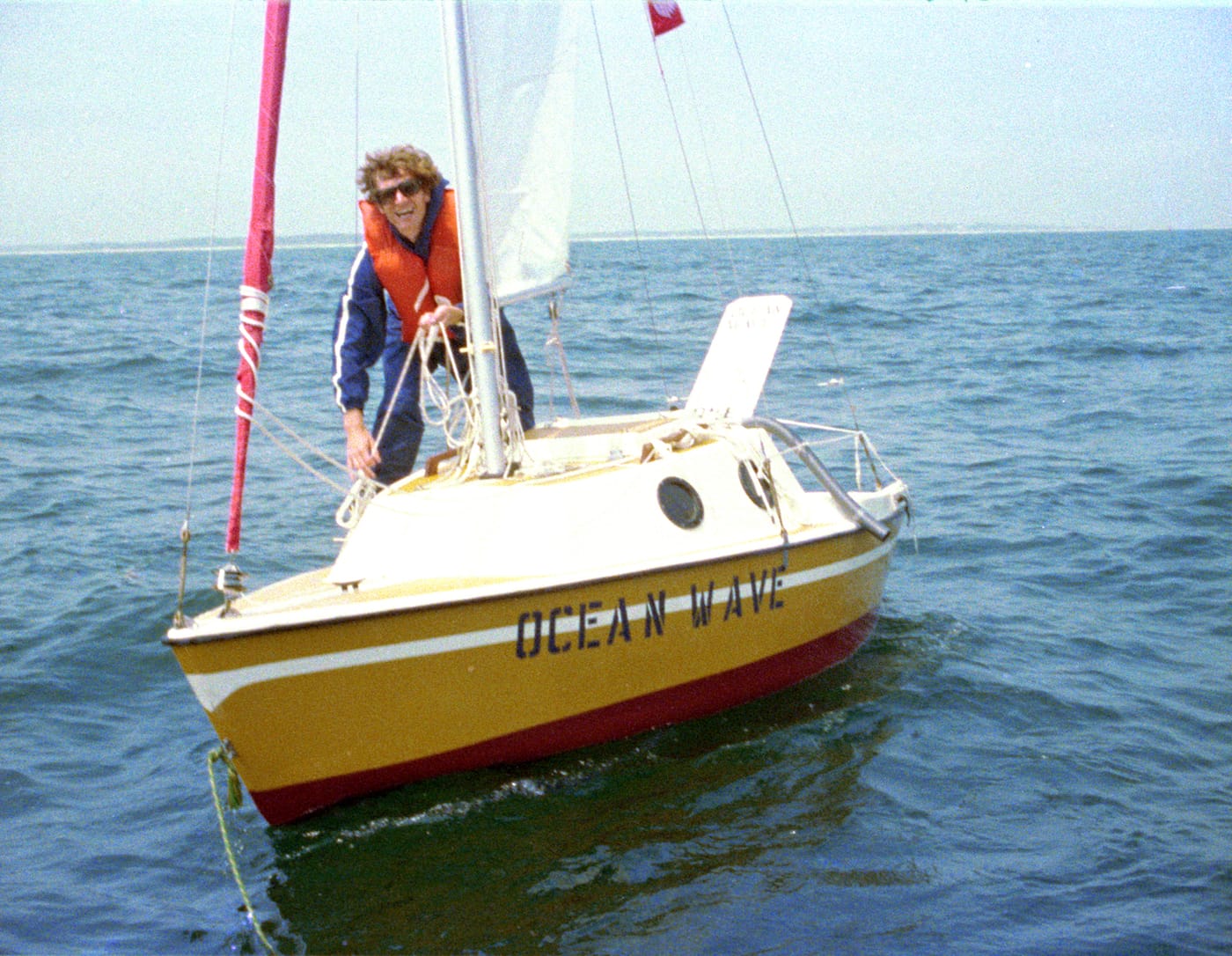
Of all those who have written about and discussed Ader’s work, Alexander Dumbadze has done the most to systematically deconstruct and dispel the rumors surrounding his death. The art historian details Ader’s preparations for the trip, including numerous modifications he had made for the Ocean Wave, such as strengthened rigging and additional layers of fiberglass. The artist’s level of sea-worthiness depends largely on whom you read. To some, his decision to sail in a 12-and-a-half foot pocket cruiser seems incomprehensible and suicidal. To others, he was well experienced. Dumbadze describes Ader’s first trans-Atlantic sail in great detail, whilst also providing an overview of his extensive sailing experience. Dumbadze confidently argues that Ader was not suicidal. He lays out the artist’s final weeks of preparations; his correspondence with Art & Project regarding recent sales and his securing of a temporary tutor in case he returned to UC Irvine later than expected. Daalder is more equivocal. “He wanted to make a masterpiece, desperately,” he states in the DVD’s Q&A. “He figured, well, look, I can’t lose. Either I cross [the Atlantic] and I’m in the Guinness Book of Records, and/or I die — and you know what, it will be a phenomenal piece of work.”
“In Search of the Miraculous” effectively functions as the apotheosis of Ader’s work. It encapsulates all of his artistic queries; his interest in the absurd, in fate, and in absence. In an eloquent passage towards the end of his book, Dumbadze gets to the very heart of the work’s allure and its enduring appeal:
Nothing is as unmediated as the end of life. It is the only event one faces absolutely alone. Death’s truth is the unknown, and for most it is experienced — before one’s own — through others … whatever happened to Ader in the waters of the North Atlantic he discovered truth as such, and in the process also made “In Search of the Miraculous” unrepresentable. Remnants like the battered Ocean Wave provided testament to the journey but nothing of the art, which rested in Ader’s person, his presence, and now his aura.
Rene Daalder’s Here is Always Somewhere Else (2007, Agitpop Media) is available from Amazon.
Alexander Dumbadze’s Bas Jan Ader: Death is Elsewhere (2013) is published by University of Chicago Press and is available from Amazon and other online booksellers.
Bas Jan Ader’s estate is represented by Meliksetian | Briggs, Los Angeles.



